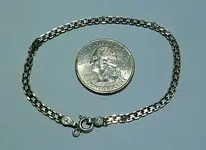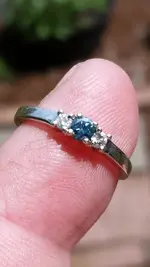Last season I swung the F4 for about 450 hrs. I did discriminate all (iron-zinc) and notched nickles back in for most public properties. When I was at an older permission property I'd notch zinc also. I only have about 60 hours on the F75 LTD SE upgraded and normally discriminate iron and foil (1-25). I may miss a small gold earring,

but I aim to be a coinshooter mainly. Old, new, clad, silver, I like coins.
As far as zinc I can't notch out or in half the segments on my F70 like you can do on the F75, but if I could I would always leave in lower zinc.
5 larger men's 10k gold class rings have come in between 48-52 for me.
I never use notch and dug all solid signals so not really an issue in my case.
Disc at 25 can miss way more than small gold earrings as stated above.
Gold chains, not small ones, either, can easily come in at the teens as masterjedi found, I just read somewhere another hunter just posted he found a really nice gold bracelet at 18.
Silver jewelry can come in really low too, especially chains.
Chains diffuse the return signal to our detectors so silver chains always come in lower than where you would expect.
If you hit a clasp, even on a larger silver chain, that could easily come in below that 25 into lower foil.
Some really small chains can actually stay in iron and an example is this very tiny one I found below.
Finally silver coins.
The Fishers seem to up-average targets in the vicinity of other metals pretty well, but under the right circumstances they will also down-average.
I can see silver coins being missed at certain sites with lots of iron.
Digging a ton of iron just to find a few silver coins might not be worth the effort, but for some it might be.
NASA Tom wrote up his experience regarding just such a scenario reprinted below.
-----------!--------------
--- Recently, I recovered a badly masked Barber dime. When I (first) detected this severely handicapped dime, the F-75 was in 'monotone', Disc '6', 'PF' and Sens on '99'. In monotone, the dime AUDIBLY sounded good. (( I was going to dig this target )). The VDI was terrible - would/could NOT lock on to anything close to resembling a highly conductive piece of silver. I then invoked 2-tone..... leaving ALL other settings alone. Now.... the dime was constantly audibly reporting as low-tone (iron-tone).....even as I rotated my body around target. The VDI was jumping all over the board. mostly in the iron ID range. I made the decision to NOT recover the target, primarily due to low iron-tone..... and walked away. Several hours later, I decided to go back and recover this target (and MANY other similar responding targets)..... with F-75 back in 'monotone'. Results = One 2" nail, two 1/2" long nails..... and one 1893 'O' Barber dime. Yep; MOSTLY iron, but certainly not ALL iron. The 2-tone mode did not lie. Justification = The composite of the 4 targets (3 nails & one dime) were higher in conductivity than any one of the nails individually...... but TOTAL conductive composite was HIGHER than any nail (or combination of nails) would have cumulatively registered. Because I (and the detector) knew that the detected target (suspected co-locate/composite of multiple targets under coil) were higher than the conductivity of most nails... yet STILL ID'd in the 'Fe/iron' range...... this target was needing recovery. Good thing! Selecting any other tone option..... and the detector would audibly report the composite as "low-tone/iron-tone". Yes, the F-75 will still unmask more non-ferrous targets than other detectors if 2-tone or multiple tones are selected; however, a substantially greater level of unmasking performance can be ascertained when unit is placed in 'monotone'. ((( The T-2 with a Disc setting of '21' is the exact same thing as all of the info above ))). Having the ability to adjust how MUCH iron you choose to discriminate.is a major attribute. Small iron items.. such as nails will Disc out at a fairly low iron Disc range.


 but I aim to be a coinshooter mainly. Old, new, clad, silver, I like coins.
but I aim to be a coinshooter mainly. Old, new, clad, silver, I like coins.

